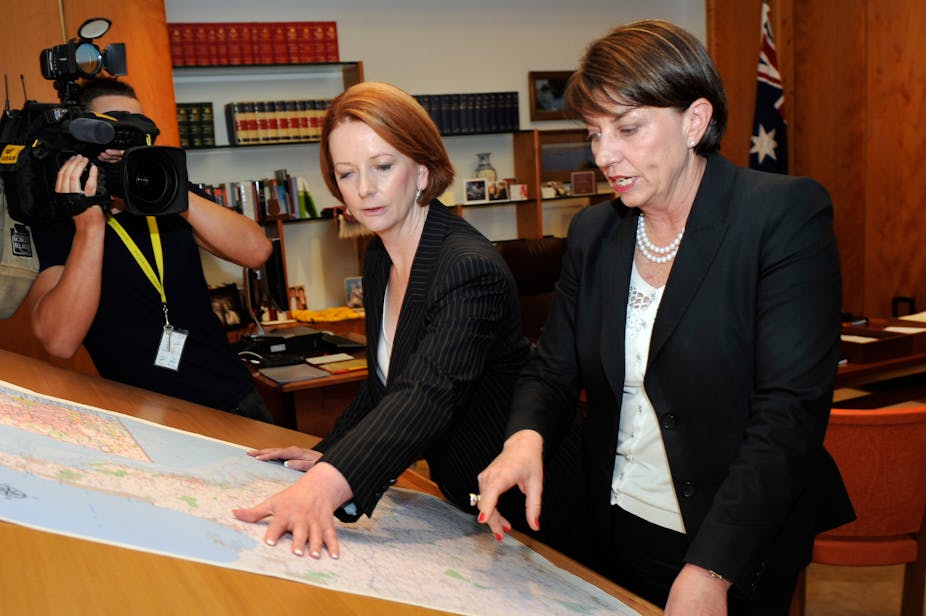A notable feature of the Queensland election outcome was, as in New South Wales last year, opinion polls correctly predicted the outcome.
In both cases, some observers found it hard to credit that Labor faced such annihilation and believed eventually some unhappy former Labor voters would come back to the party. But in both states voters became unhappier as the campaign progressed.
Since Julia Gillard’s defeat of Kevin Rudd Labor, supporters and some journalists have pointed out federal Labor’s opinion poll ratings are respectable and that the party’s fortunes have improved notably over the last year to a level where Labor would suffer a modest defeat at an election now rather than a Queensland or NSW-style electoral apocalypse as once seemed likely. But the fact remains that on current poll trends Labor will lose the federal election.
Labor cannot win a national election on the basis of South Australia, Victoria and Tasmania alone. At the last election Labor’s loss of seven seats in Queensland brought it to the edge of defeat despite record levels of support in the three southern states.
The historical precedent is for severe Labor reverses at the state level in Queensland to be followed by major losses at the next federal election, such as in 1975 and 1996. Since World War II it has been a rare federal Labor leader who has enthused Queenslanders; Bob Hawke and Kevin Rudd were successful but Ben Chifley, Gough Whitlam and Paul Keating were not and Julia Gillard seems to fall in the latter category.
The importance of Queensland for federal Labor is bolstered by the fact that currently the main constituency where Labor has made up ground since 2010 is among non-Anglo voters disenchanted by Labor’s “sustainable population” rhetoric in 2010. These voters mostly live in safe Labor seats where their return to the party is electorally irrelevant.
In the past, Labor collapses in Queensland such as 1949, 1975 and 1996 have provided icing on the cake for a federal Coalition already carried to victory by the suburbs of Sydney and Melbourne.
Now, however, Queensland alone could account for Labor’s defeat as it almost did in 2010. Australian politics shows signs of following the Canadian pattern of a division between resource states and the rest. The mining boom threatens the viability of services and manufacturing in the southern states but attempts to redistribute its gains meet a hostile response in Queensland and Western Australia. Anna Bligh’s government was lukewarm enough about the mining tax. Campbell Newman will employ Queensland provincialism as a tool against Gillard’s re-election.
Queensland Labor’s wipeout has implications for the party’s viability. One is the loss of likely donations from business, always declined to back losers, and also the collapse of party income drawn from levies on members of parliament.
More serious in the long term is that without the focus point of local MPs and staff Labor branch organisation, already atrophied, will collapse further.
The Queensland result demonstrates that Labor’s reliable base has shrunk to under 30% of voters. Both the New South Wales and Queensland governments largely failed to run on their record during the recent election campaigns.
Little attempt was made to give voters a positive reason for supporting Labor. Labor fell back on focus-group derived promises about the cost of living, the fast-wasting personal appeal of the incumbent premiers and to Labor core supporters an empty rhetoric of pride in Labor as an end in itself. Paul Keating’s evocation of the “true believers” overstated in 1993 has by 2012 become an empty cliché.
Privatisation in New South Wales and Queensland, although not a first order issue to the electorate, contributed to the demobilisation of Labor supporters, particularly in Queensland.
The federal government has shown some awareness of the fragility of Labor’s base after the disastrous 2010 federal election campaign. Federal Labor has more to boast about: both Fair Work Australia and the carbon tax enthuse Labor branch activists. The federal government is also not seen as having failed in service delivery. Tony Abbott, unlike Barry O’Farrell, Campbell Newman or John Howard in 1995-96 does not reassure voters.
The Queensland result is a stark indication of Labor’s political difficulties. It is true that the campaign was decided on state issues but Queensland Labor had come to exemplify the political style of modern Labor: a focus on leadership, the promise of service delivery (despite limited real increases in resources), media management and a relentless tracking of the political centre.
This model triumphed at the state level for over a decade in NSW and Queensland but it has exhausted its potential. At the federal level the collapse of this new Labor model has been much more dramatic.

